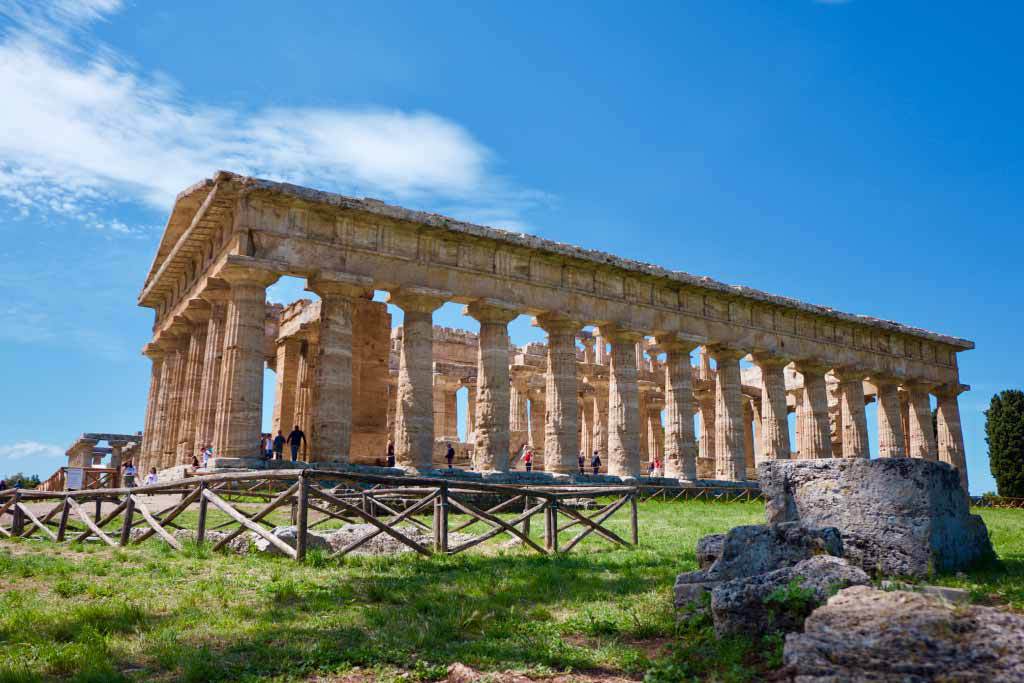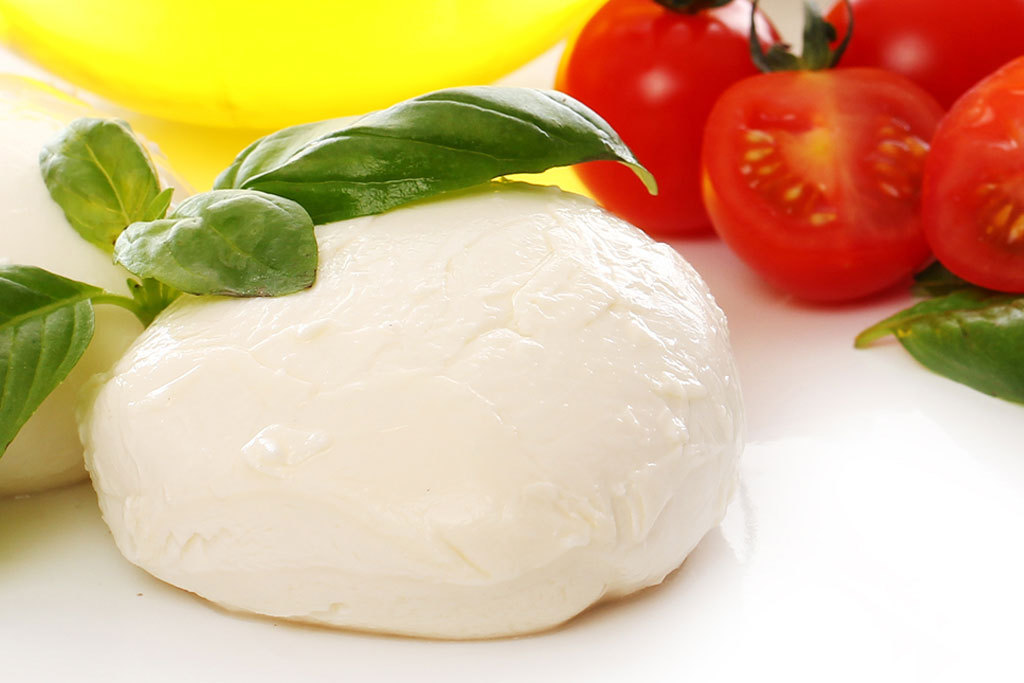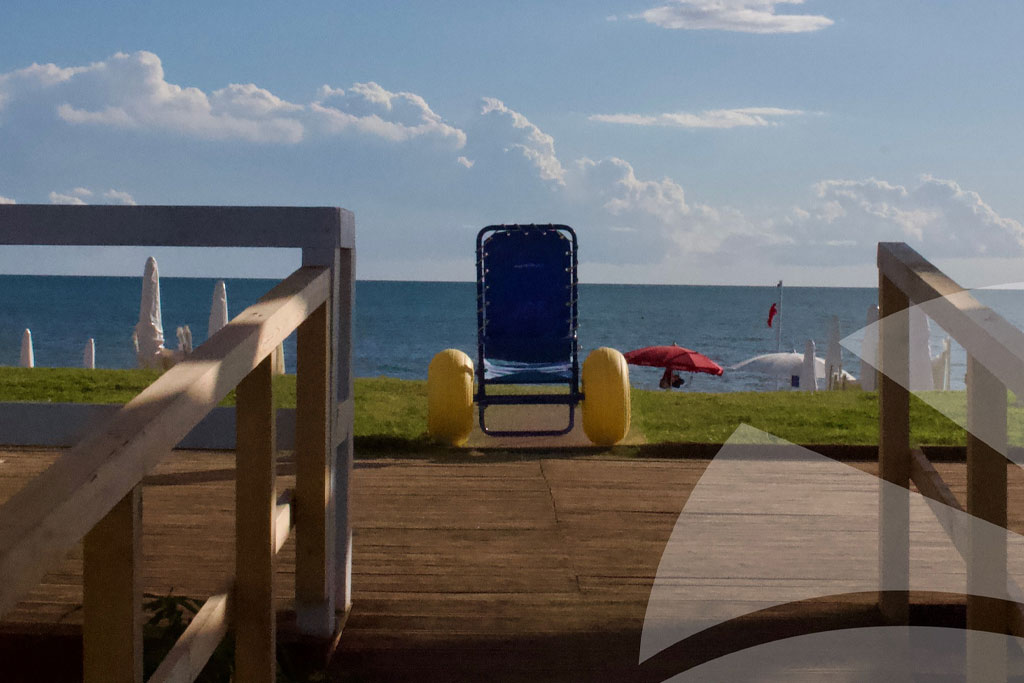In the immediate vicinity of Salerno, in the heart of the Sele Valley, lies the ancient city of Paestum, originally called Poseidonia by the Greeks in honour of Poseidon.
The city, part of the municipality of Capaccio Paestum, has a strategic position between the capital of Campania and the National Park of Cilento, Vallo di Diano and Alburni. It runs along a coastline of fine sand that is separated from the coastal road by a thick pine forest, a natural shelter from the summer heat and the backdrop for spectacular sunsets.
Paestum has a thousand-year history to tell anyone who wants to can lose themselves in the beauty of its temples, unique examples of the architecture of glorious Magna Graecia.
The archaeological area of Paestum
In the archaeological area of Paestum, it is easy to be amazed by the majestic beauty of the Temple dedicated to Neptune. Considered a perfect model of Doric architecture, it is the largest temple of the ancient polis of Poseidonia and is among the best preserved. Slightly further south stands the Basilica or Temple of Hera, bride of Zeus, dating from around 500 B.C.. The Basilica has a peristasis consisting of nine columns on the front and eighteen on the sides that are incredibly well preserved.
Dating from the same historical period is the Temple dedicated to Athena, which has a high pediment that makes it unique and among the most interesting of Greek architecture.
In the archaeological area, the remains of the ancient Amphitheatre, the Agora, the political heart of the polis, and the Forum are also clearly visible.
It is in the National Archaeological Museum that the famous Tomb of the Diver is kept. Its painted slabs are of inestimable historical and cultural value as the only example of painting from the Greek period in Magna Graecia.
The museum has a section entirely dedicated to the Roman conquest period as well as a section devoted to architectural decorations and sculptures from the excavations.
To the south of the archaeological area, an imposing city wall stretches for about 5 km in length and 7 metres in original height. It represents one of the grandest systems of fortifications of its time and at nightfall with the night lighting it becomes particularly fascinating, making the beauty within it perceptible.
In recent years, the City of Temples has been hosting concerts and theatre performances on summer evenings. An evocative location and stage, highly recommended.
Also suggestive is the scenery that can be enjoyed from the hot-air balloons that fly over the archaeological area during the festival in which they take centre stage (usually between September and October). Every year in early autumn, dozens of giant, colourful balloons rise into the sky amidst the enthusiasm of onlookers and enthusiasts.
Paestum between taste, sea and tradition
It is impossible, and not only for the greedy, not to associate the Paestum area with the mozzarella di bufala campana D.O.P., the undisputed queen of Mediterranean cuisine. In fact, the Capaccio-Paestum area is the cradle of the world’s best mozzarella. Over the years, farmers in various regions of Italy have tried to export buffaloes from Campania to reproduce the prized white gold, but the result has never been similar to the original. The cheese factories and farms in the area surrounding Paestum are many, but among them, a special mention goes to Tenuta Vannulo where you can taste mozzarella, bocconcini, yoghurt, ice cream and puddings made with buffalo milk and also take a guided tour of the modern stables and dairy production workshops.
The estate is one of the few local companies that has decided not to export its products and is therefore the sole retailer, thus increasing the value of its production.
The zero-kilometre chain of mozzarella also characterises the products of the Riva Bianca dairy and the Granato dairy, which maintain strong ties with the land and traditions.
Another pride of Paestum is its IPG artichoke known as Tondo di Paestum, medium-sized and green in colour with violet-pink hues, which is particularly tasty and used in the preparation of various and typical dishes such as pizza with artichokes, cream and artichoke pie, much appreciated by tourists in the Valley of the Temples.
The Sele plain is also home to the production of numerous wines. Paestum IPG includes the following types: Bianco, Rosso, Rosato, Passito Bianco, Passito Rosso and Novello, all produced in the vineyards of the Salerno province.
But Paestum is also and above all sea.
The entire coastline is characterised by a dense pine forest close to the beaches that provides precious shade for bathers.
The beaches are characterised by a sea with a shallow, sandy seabed. Crystal-clear waters characterise the entire coastline, which has been awarded the famous Blue Flag several times.
With no insidious stones or rocks at the water’s edge, the sea at Paestum is truly accessible to all, including children. In fact, several tens of metres must be covered before the seabed becomes deep, an essential factor for mothers and fathers who can let their children play in the water in peace, but must always be careful of eddies.
The sandy beach is also ideal for those who like to stroll by the sea, a pleasant experience thanks to the light wind characteristic of the area.
On the Paestum coast, hundreds of metres of wide free beaches of fine sand alternate with numerous lidos that welcome young and old in the province of Salerno as well as numerous tourists from all over Italy and beyond. In summer, Paestum’s lidos stay open until late afternoon to allow guests to enjoy a well-deserved aperitif and some liven up summer nights with dancing, initiatives and musical events of various kinds.
These include Dum Dum Republic, the free-spirit beach with a green and slightly freak soul where it is possible to dine by the sea while listening to good live music.
Staying on the coastal side, the Legambiente Dune Oasis is worth a visit. Once a dump, today thanks to the passionate work of volunteers it is an equipped and clean natural area, a tangible example of alternative tourism.
Paestum and its beaches are easy to reach thanks to the railway station of the same name, which is only 15 minutes from the archaeological area, but also thanks to the road connections of State Road 18 and the coastal road that runs alongside its extensive pine forest. Salerno can be reached in just under half an hour by car, while the ancient village of Agropoli and its spectacular Bay of Trentova are just over 15 km away.
Paestum is art and history under the open sky. An ideal destination for holidaymakers wishing to combine culture and relaxation.




